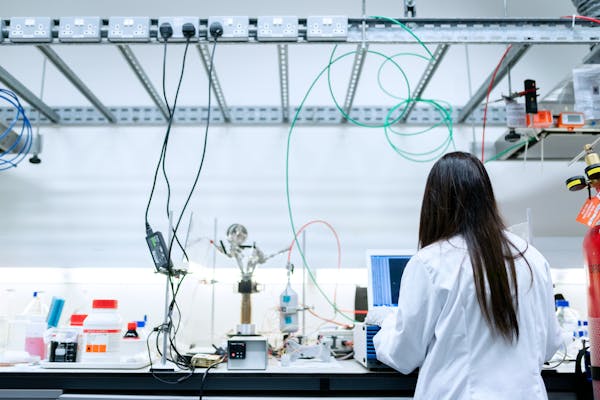
The pace of technological advancement continues to accelerate, reshaping industries, economies, and the very fabric of society. The latest tech innovations are transformative, creating opportunities and challenges alike. From artificial intelligence (AI) to quantum computing, biotechnology, and renewable energy, new breakthroughs are pushing the boundaries of what’s possible. This article will explore the most recent technological advancements and how they are poised to impact various sectors globally.
Explore The Latest Tech Innovation of This Year
1. The AI Revolution: More Human-Like Intelligence
Artificial intelligence has been a critical driving force in the latest tech innovations, This year, it is reaching new heights. The development of more sophisticated AI models, such as OpenAI’s GPT-4 and beyond, demonstrates unprecedented levels of machine learning capabilities. AI has evolved from merely performing tasks like image recognition and natural language processing (NLP) to more complex operations, including decision-making, problem-solving, and creative endeavors.
AI in Business and Healthcare
Businesses are increasingly relying on AI to enhance operational efficiency, customer experience, and product innovation. For instance, AI-powered chatbots are becoming more intuitive, enabling businesses to automate customer service while maintaining a human-like interaction. Moreover, AI’s predictive analytics capabilities are helping companies anticipate market trends and consumer behavior, allowing for better strategic planning and inventory management.
In healthcare, AI’s applications are particularly revolutionary. From drug discovery to diagnostics and personalized treatment plans, AI is proving indispensable. Machine learning models are being trained on vast datasets to predict the likelihood of diseases like cancer, heart disease, and diabetes before they manifest, providing healthcare professionals with the tools to offer early interventions. AI is also enhancing telemedicine, allowing remote patient monitoring and virtual healthcare consultations to be more effective.
AI and Creativity
One of the most fascinating latest tech innovations in AI is its ability to mimic human creativity. AI models are now generating art, music, and even writing. With developments in generative AI, machines can now produce original content, raising questions about the future of creative industries. Artists and musicians are already collaborating with AI systems to create hybrid forms of expression, blending human creativity with machine precision.
2. Quantum Computing: A Leap Beyond Classical Computing
While AI has dominated much of the technological conversation in recent years, quantum computing represents the next frontier in computing power. As one of the latest tech innovations, quantum computing promises to solve problems that are currently beyond the capabilities of classical computers.
Quantum computers leverage the principles of quantum mechanics to perform calculations at speeds exponentially faster than today’s supercomputers. This technology is particularly promising in fields like cryptography, materials science, and complex system simulations. The potential for quantum computing to break traditional encryption methods has significant implications for cybersecurity, necessitating the development of quantum-safe encryption techniques.
Applications in Drug Discovery and Finance
In drug discovery, quantum computing could revolutionize the process by simulating molecular interactions at an unprecedented scale and speed. This would significantly reduce the time and cost of developing new medications, potentially leading to cures for previously untreatable diseases.
The financial sector is also poised to benefit from quantum computing. Quantum algorithms could optimize complex trading strategies, analyze large datasets in real-time, and improve risk management practices. This has the potential to reshape the global economy by creating more efficient and secure financial systems.
3. Biotechnology: Merging Biology with Technology
Biotechnology continues to be a field ripe with innovation. The convergence of biology and technology is leading to groundbreaking advancements in medicine, agriculture, and environmental sustainability. One of the most exciting latest tech innovations in this space is CRISPR, a revolutionary gene-editing technology that allows for precise modifications of DNA sequences.
Gene Editing and Personalized Medicine
CRISPR technology has advanced significantly this year, with scientists now able to edit genes in living organisms with remarkable accuracy. This has opened the door to personalized medicine, where treatments are tailored to an individual’s genetic makeup. Diseases caused by genetic mutations, such as cystic fibrosis and sickle cell anemia, are now being targeted with gene-editing therapies, offering the possibility of permanent cures.
Moreover, biotechnology is playing a crucial role in the development of vaccines and therapies for emerging infectious diseases. The rapid development of mRNA vaccines for COVID-19 has paved the way for new vaccines that can be quickly adapted to combat future pandemics.
Agricultural Innovation
In agriculture, biotechnology is helping to address the challenges of food security and climate change. Genetically modified crops that are resistant to pests, diseases, and extreme weather conditions are becoming more common, reducing the reliance on chemical pesticides and increasing crop yields. Additionally, advances in lab-grown meat and alternative proteins are offering sustainable solutions to meet the growing global demand for food while reducing the environmental impact of traditional livestock farming.
4. Renewable Energy: Powering the Future
As the world grapples with the effects of climate change, renewable energy is at the forefront of the latest tech innovations aimed at reducing carbon emissions and transitioning to a more sustainable future. This year, the renewable energy sector is experiencing rapid growth, with advancements in solar, wind, and energy storage technologies.
Solar and Wind Power Innovations
Solar power has become more efficient and affordable than ever before, thanks to improvements in photovoltaic cell technology. The latest solar panels are able to convert a higher percentage of sunlight into electricity, making solar energy a more viable option for both residential and commercial use. Additionally, floating solar farms are being deployed on bodies of water, maximizing the use of space and increasing energy production.
Wind power is also benefiting from technological innovations. Offshore wind farms are growing in size and capacity, with turbines that are capable of generating more electricity than their predecessors. These new turbines are designed to withstand harsh ocean conditions, making offshore wind a reliable source of renewable energy.
Energy Storage and Grid Modernization
One of the biggest challenges facing renewable energy is storage, as solar and wind power are intermittent sources of energy. However, advancements in battery technology, particularly in lithium-ion and solid-state batteries, are addressing this issue. This year, energy storage systems are becoming more efficient, enabling the storage of surplus energy generated during peak production periods for use when demand is high.
In addition, the modernization of electrical grids is crucial to the widespread adoption of renewable energy. Smart grids, which use digital technology to monitor and manage the flow of electricity, are being deployed in many regions to optimize energy distribution and integrate renewable sources more effectively.
5. 5G and Beyond: The Future of Connectivity
The rollout of 5G technology is one of the latest tech innovations that is transforming the way we live and work. With its ultra-fast speeds, low latency, and ability to connect billions of devices, 5G is enabling the growth of the Internet of Things (IoT), autonomous vehicles, and smart cities.
IoT and Smart Cities
The Internet of Things refers to the network of connected devices that communicate with each other and with users over the internet. This year, IoT is becoming more prevalent in homes, businesses, and public infrastructure. Smart thermostats, security systems, and appliances are now common in households, allowing for greater control over energy consumption and improved security.
In smart cities, IoT devices are being used to monitor traffic, reduce energy consumption, and improve public safety. Sensors embedded in roads, bridges, and buildings provide real-time data on structural integrity and traffic flow, allowing for predictive maintenance and more efficient urban planning.
Autonomous Vehicles and Transportation
The transportation sector is also undergoing a transformation, thanks to advancements in connectivity. Autonomous vehicles, which rely on 5G networks to communicate with each other and with traffic management systems, are becoming a reality. These vehicles have the potential to reduce traffic accidents, improve fuel efficiency, and decrease congestion in urban areas.
Moreover, the integration of 5G with other emerging technologies, such as AI and edge computing, is enabling real-time data processing at the source, reducing the need for centralized data centers and improving response times in critical applications.
6. The Metaverse: A New Digital Frontier
One of the latest tech innovations capturing the imagination of both consumers and businesses is the metaverse. The metaverse refers to a collective virtual space where users can interact with each other and digital environments in real time. It is a fusion of augmented reality (AR), virtual reality (VR), and the internet, creating immersive digital experiences.
Business and Entertainment in the Metaverse
The metaverse is becoming a platform for commerce, entertainment, and social interaction. Companies are creating virtual storefronts where users can browse and purchase products in a 3D environment. Brands are also using the metaverse to host virtual events, product launches, and concerts, reaching a global audience in a highly engaging way.
The gaming industry is leading the charge in the metaverse, with multiplayer online games becoming more immersive and interactive. Players can now explore vast virtual worlds, interact with other players, and even earn real-world currency through in-game transactions.
Education and Collaboration
Beyond entertainment, the metaverse is being used for educational purposes. Virtual classrooms and training programs are providing students and professionals with interactive learning experiences that are not possible in traditional settings. For example, medical students can practice surgical procedures in a virtual environment, gaining hands-on experience without the risks associated with real-life operations.
The metaverse is also transforming the way businesses collaborate. Virtual meetings, conferences, and workspaces allow teams to collaborate in real-time, regardless of their physical location. This is particularly important in a world where remote work is becoming more common.
7. Blockchain and Decentralized Finance (DeFi)
Blockchain technology, the backbone of cryptocurrencies like Bitcoin and Ethereum, continues to be a significant latest tech innovation. However, its applications extend far beyond digital currencies. Blockchain’s decentralized nature is transforming industries by providing secure, transparent, and tamper-proof systems for recording and verifying transactions.
Decentralized Finance (DeFi)
Decentralized finance, or DeFi, is one of the most promising applications of blockchain technology. DeFi platforms use smart contracts to automate financial transactions, such as lending, borrowing, and trading, without the need for intermediaries like banks. This has the potential to democratize access to financial services, particularly in regions where traditional banking systems are underdeveloped.
In addition, blockchain is being used in supply chain management, healthcare, and voting systems to improve transparency and security. For example, blockchain can provide a tamper-proof record of the journey a product takes from manufacturer to consumer, ensuring the authenticity of goods and reducing the risk of fraud.
8. Human Augmentation and Wearable Technology
The integration of technology with the human body, known as human augmentation, is one of the most cutting-edge latest tech innovations. Wearable technology, such as smartwatches and fitness trackers, has become increasingly sophisticated, providing users with real-time data on their health and fitness levels.
Exoskeletons and Prosthetics
In addition to consumer wearables, human augmentation is making strides in the medical field. Exoskeletons, which are wearable robotic devices that enhance a person’s physical capabilities, are being used to help individuals with mobility impairments walk again. Prosthetics are also becoming more advanced, with the development of bionic limbs that can be controlled by the user’s nervous system, allowing for more natural movement.
Brain-Computer Interfaces
One of the most futuristic applications of human augmentation is brain-computer interfaces (BCIs), which allow users to control devices with their thoughts. BCIs are still in the early stages of development, but they have the potential to revolutionize how we interact with technology. For example, BCIs could enable individuals with paralysis to control computers, prosthetics, and other devices, improving their quality of life.
Conclusion
The latest tech innovations are pushing the boundaries of what is possible, transforming industries, and improving the quality of life for people around the world. From AI and quantum computing to biotechnology, renewable energy, and the metaverse, these advancements are creating new opportunities while posing important ethical and societal questions. As technology continues to evolve, it is essential for policymakers, businesses, and individuals to consider the long-term implications of these innovations and work towards ensuring that they benefit society as a whole.


